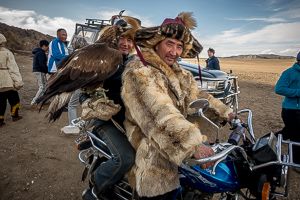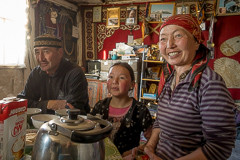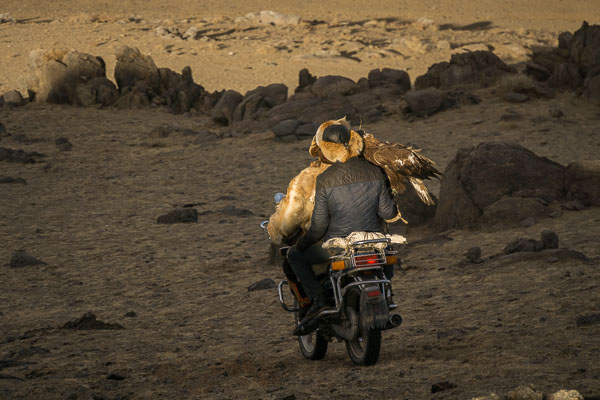Eagle Hunters

Agalai and his Eagle
Much of the recent interest in eagle hunters has been sparked by photographs made by Asher Svidensky that went viral several years ago, as well as The Eagle Huntress, a more recent documentary film by Otto Bell, that got lots of attention at the Sundance Film Festival. The subject of both the photographs and the film is a young woman named Aisholpan, whose father Argalai began teaching her to handle eagles when she was thirteen years old, at a time when her older brother was too busy with other commitments to learn the craft. It was a radical decision, for handling eagles has always been men's work. It was also a very fortunate decision. Something about a young woman wading into a man's ancient tradition has struck a chord for many people around the world. It doesn't hurt that for such a young woman, Aisholpan has a fearless and direct presence—not just around eagles, but before a camera.
Several years older now, Aisholpan is still a celebrity in Mongolia. When she made an appearance at the Ulaanbaatar Eagle Festival that I wrote about two months ago she was swarmed by admirers, who abandonded their hard-won positions at the roped exhibition area to have their photos taken with her. With her parents, she has traveled to the United States, both to Park City, Utah, for the film festival and to New York City.
So I was taken back, two days before our trip, when Nurbolat mentioned casually on the phone, in a clarification of our itinerary, that we would be spending the night at Aisholpan's house. He had promised an eagle hunter, but not the eagle hunter.
As it happened, Aisholpan was not home for our visit, but staying in Ulgii. Famous or not, students her age in the Mongolian countryside must travel to the largest closest city to attend a school, where they board for the week. Although she has received the promise of a scholarship to a university in New York, she still needs to finish high school here.

Agalai, Saigulik, Alma
When tourists come so far to get to this part of Mongolia, there's an understandable desire to bring home pictures of a culture that is unique, or perhaps one that is still somehow untouched by time, but that is not the real story either. In the afternoon Argalai watches a horse race on his solar powered television, makes an appointment to have a tooth pulled with his mobile phone. He has skills that have taken generations to perfect but will take only one or two to lose in a world where the need for animal skins is replaced by the need for money. Tourism is the bargain he makes to keep one foot in each world, and it is not an easy bargain. The next afternoon as we are leaving for the Ulgii, an hour away, Agalai asked for a ride to go see his dentist. Although the film his daughter is featured in, and in which he participated behind the scenes, made its filmmaker nearly two million dollars, he does not own a vehicle to drive to town. He will spend the night with friends and take a taxi home the next day.
At the airport two days later I chatted with two Australian tourists, comparing notes on our travels. We all agreed that we just had a remarkable trip. "What did you do?" asked one of the women.
I told her that we had seen eagle hunters. "Which eagle hunters?" she asked.
"Agalai and his family."
"That's where we stayed too!" she told me.
